How We Prepare Our RV For Cold Weather Living
This post may contain affiliate links.
One of the most common questions I see in full-time RV forums is “What do I need to do to prepare for RVing in the winter?”
I’ve survived many winters in my RV without issue! All you need is a little preparation to know how to protect your RV, stay warm, and save on heating costs.
6 Things We Do to Prepare for RVing in the Winter
In this article, I’ll be sharing how we do the following:
- Protect the water supply system from freezing and pipes from bursting
- Protect the sewage system from freezing
- Supplement our RV’s furnace with other heat sources
- Skirt our RV with inexpensive DIY RV skirting
- Insulate our RV windows (without blocking out the sunlight!)
- Insulate our slideouts to prevent heat loss through the floors
Here’s a quick video overview:
What Our Climate is Like in Winter
Since buying my RV in the summer of 2016, we have been parked stationary in Kansas City. The climate here is not as severe as in some places where people might be living or camping in the winter. But temperatures are regularly below freezing.
A typical winter day in this part of the country is below freezing at night and above freezing (in the 30s or 40s) during the day. Usually, we will get a couple of weeks each year where the high temperatures don’t get above freezing and the lows are close to zero, but we rarely get sub-zero or negative temperatures.
And although we usually get at least some snow and possibly ice, the snow doesn’t stay on the ground for more than a few days.
Do you need a four-season RV for winter camping?
We live in a 2009 Keystone Everest, which is a 38-foot fifth wheel with four slide-outs.

It is a four-season RV, which means it includes the following features to help insulate and protect against cold weather:
- Extra insulation
- Vents in the roof to release excess moisture from the “attic”
- An enclosed underbelly
- Heat ducts and vents in the storage bay area, where much of the plumbing system is located
- An enclosed water connection point with a heater vent blowing into the enclosure
We specifically shopped for a four-season RV because we knew we would be spending winters in cold weather. However, it is possible to camp in the winter even without a four-season RV, especially if you prepare properly.
For a list of the features to look for in a four-season RV, check out my Guide to Buying an RV to Use in Cold Weather.
1. Protecting our Water Supply System from Freezing
Our RV stays connected to a city water supply and we need to protect our freshwater line from freezing.
To do this we purchased a heated water hose. Some people wrap their regular water hose with heat cable and pipe insulation. But our water connection is so far from our RV that we wouldn’t have saved much money doing it that way.
- PROVIDES FREEZE PROTECTION: This 50-foot long Camco heated water hose for RVs features thermostat-controlled technology, ideal for water line freeze protection down to -20°F (-28°C).
We did have one issue with freezing last year. The city water pipe sticking out of the ground—that our mobile home park winterized—froze. The only thing they had done to protect the pipe from freezing was to wrap it with insulation and plastic, and the part right next to the ground wasn’t adequately protected. It froze during a cold snap where the highs were in the single digits.
Here’s a photo of the mobile home park’s inadequate insulation job:

After a neighbor helped us thaw the pipes with a high-powered industrial heater, I removed the park’s insulation and wrapped the pipe with electric heat tape. Then I covered it with more insulation and plastic.

And, for good measure, I lined a Rubbermaid storage tote with foam board and put it upside down over pipe.

It did not freeze again!
2. Protecting Our Sewage Pipes from Freezing
Some people leave both their gray and black tanks closed during cold weather and only open them for dumping. This is a great way way to not worry about your sewage pipe freezing.
But we really wanted to be able to leave our gray tank open and not have to worry about it.
After a lot of research, I realized that unless we were in a climate where liquid could freeze during the amount of time it took to travel through the hose (which we were not), it would be okay to leave our hose hooked up. We left our gray tank open and set it up to drain quickly without any places where liquid could collect.
This involved building a downhill track out of cheap vinyl guttering and cinder blocks. (We did have sewer hose supports, but they constantly fell over and we wanted something sturdier.)

Additionally, our sewer hose runs under the bottom of our RV and is fully enclosed with skirting, so frozen sewage hasn’t been a problem for us.
As for our grey and black tanks, they stayed plenty warm because of our skirting. For RVs that need extra protection against frozen tanks, tank heaters or a non-LED lightbulb will do the trick. However, it’s important to make sure that pipes in addition to tanks are protected from freezing.
3. Supplemental Heat Sources
When the temperatures dip below freezing, we make sure to run our RV furnace so it can blow into our storage bay and keep our pipes and tanks warm.
But we use electric heat as a backup for when we run out of propane in the middle of the night—because that will inevitably happen at least once. Plus it’s cheaper for us as a main source of heat.
These are our preferred electric heat sources:
- An infrared heater, Dr. Infrared brand. We love this thing! It heats our whole lower level pretty evenly, stays cool to the touch, and has a thermostat.
- Our electric fireplace heater, which is built into the RV.
- A little ceramic space heater for our bedroom.
- Can heat up a large room with Auto Energy Saving Model With High and Low Feature. Tip-over protection and Overheat protection.Heat Up for a large room - Dual Heating System: Infrared Quartz tube + PTC for 60% more heat than others. Rated around 5200 BTU.
Although many or even most cold-weather RVers use electric heaters, there are some safety risks associated with running a space heater in an RV you need to be aware of.
Read Next: “Is it Safe to Use a Space Heater in an RV?” for more information.
For propane heat, we have two 7-gallon propane tanks. Here is a rough estimate of our propane usage for a few of the winter months based on my notes:
- October – about 20 gallons
- November – about 22 gallons
- December – about 35 gallons
- January – about 35 gallons
We buy propane either from a nearby U-Haul, which is more expensive (over $3/gallon including their base fee), or from Tractor Supply Co., which is cheaper ($1.86/gallon last winter, and they don’t charge any additional fees) but is unfortunately located 30 min. away from us.
If you’re in a motorhome, you can fill up at truck stops or ask your RV park if they have a local propane delivery truck that they work with. In this case, a propane truck will drive straight to your RV park and fill your tanks for you.
More Options for Heating an RV
I want to briefly mention a couple of other options for heating an RV during winter, even though I haven’t tried these myself, so that you can be aware of them as you’re considering the best solutions for your situation:
Heating an RV with a Wood Stove
I know this may sound crazy, but believe it or not, there are actually quite a few people who have installed a small wood stove in their RV as an off-grid heating source. Many of these people are stationary RVers, but some of them travel.
Read Next: Heating an RV with an RV Wood Stove: 8 Best RV Wood Stoves
“CheapHeat” RV Furnace Modification
A company called RV Comfort Systems has developed a way to modify an RV furnace to run on electricity instead of propane called CheapHeat. You can add a control switch to be able to easily switch it from propane to electricity and vice versa depending on which one is more affordable for you at the time.
The company provides documentation for the installation process so that you can have it installed by any licensed RV mechanic so you don’t have to worry about whether or not it’s safe to use.
4. RV Skirting
I didn’t know if we actually needed skirting to keep our pipes and tanks from freezing. For four-season RVs, they aren’t required to protect your systems. But they will keep you significantly warmer inside and prevent heat loss.
We made our own removable, reusable vinyl skirting out of recycled billboard vinyl for around $200, which you can read a tutorial on here.

Later, we ended up staying at an RV park that only allowed foam board skirting, so I made foam board skirting (for about half the cost!).

If you’re a winter traveler, however, the above two options won’t work for you.
For travelers, I’d recommend a newer type of inflatable RV skirting called AirSkirts. It’s designed to be easy to set up and take down for travelers RVing in the winter.

5. Insulating RV Windows
Our RV windows are only single pane, so we cover them with plastic to reduce heat loss in our RV, and it makes such a big difference. (Some four-season RVs will have double-pane windows so you can skip this step.)
Some people cover their windows with Reflectix in the winter, but having sunlight in my home during winter has a positive influence on my mood. I can’t stand covering my windows and making my home feel like a cave! I have to use something that still lets light through.

Last year we covered our windows with a combination of bubble wrap and shrink plastic, and this year I made storm windows out of plexiglass and removable Velcro covers for the screens from clear vinyl.
I share in-depth tutorials on how to insulate your windows here.
- 【STAY TEMPERATURE YEAR-ROUND】- SIKADEER RV Skylight Insulation Cover blocks the air and heat exchange between the inside and outside. This allows your Camper to warm quickly in winter and cool quickly in summer, reducing energy consumption.
I also put plush insulators in my RV’s vents to prevent heat from escaping there. You can buy these on Amazon.
If you have a skylight you’d like to insulate, this inflatable skylight insulator sticks to your skylight with suction cups and still lets the sunshine through.

Preventing and Dealing with Condensation
Some people who full full-time in an RV in cold winter climates have problems with condensation accumulating on the windows, like you saw in the photo above. Insulating the windows can make a big difference in preventing RV condensation.
Running a humidifier can help as well, but just lowering the humidity alone can still result in money literally going out the window as your heat escapes.
If you do insulate your windows, you may find this alone solves the condensation problem. (If not, check out our blog on what causes condensation in RVs and ways to prevent it.)
6. Reducing Heat Loss in Our Slides
Even after putting on our skirting last year, I noticed that the floors of the slides in our living area were extremely cold.
There didn’t seem to be a draft, and the seals around the edges of the slides seemed fine. It was actually the floors themselves that were, according to my thermometer, a good 20 degrees colder than the rest of the room.
To solve this problem, I went to Lowe’s and purchased some foam board, and we duct-taped it to the bottom of each slide. This made a huge difference in the temperature of the floor and the warmth of the whole RV!

If I had it to do over again, though, I would use HVAC tape instead of duct tape as it holds in all kinds of weather and doesn’t leave a residue when removed. Duct tape will leave a mess!
Insulating Our Closet
The walls of our closet seem to be more poorly insulated than the rest of our RV, which makes our bedroom feel pretty drafty on cold nights.
In the past, I tried taping some extra Reflectix to closet walls to see if it would help. But then I heard of some people having problems with condensation accumulating underneath the Reflectix, so I abandoned this idea.
Then one of my subscribers sent me an idea that I love.
- STONE TEN FOAM WOOD WALL PANELS - Rejuvenate bland, boring walls and create a rustic space that you'll love for years to come. Whether you’re looking to create a textured accent wall or a large wood surface, Stone Ten Foam Wood Panels are an economical way to create a beautiful distressed wood wall to spruce up your living space.
She found a moisture-resistant, adhesive foam panel product designed to look like wood planks or white bricks.

I loved how the product made the closet look, so I decided to try it, figuring that even if it didn’t help with the cold, at least it would look better than the beige wallpaper. I’d always regretted leaving the closet unpainted when we painted our RV’s walls!
I love the results and the closet feels warmer now. I share more on how I accomplished this project in this video:
More RVing in the Winter Tips from Other RVers
Here are a few cold-weather camping tips I’ve seen from people who live in cold climates:
- Line the backs of cabinets (that are on an exterior wall) with Reflectix to help prevent heat from escaping through the walls.
- Spray the bottom of the camper with spray foam. (Make sure to not spray anything that would prevent access to certain systems if they need repair.) An alternative is to attach foam board insulation to the bottom of the RV.
- Put Reflectix on the backs of storage bay access doors to help insulate the space under the RV.
- Wrap the slides with foam board or vinyl to cut down on heat loss through the walls, tops, and floors of slideouts.

Read Next: 6 Ways to Insulate Your RV Windows (That Don’t Block the Light!)
Ashley Mann spent three years living full time in a 38-foot, 5th-wheel RV with her husband Josiah and their cat, Kitty. Her favorite thing about RV life is the challenge of finding the perfect way to organize a space, and she loves seeing all the creative and clever ways people come up with to customize their RVs.

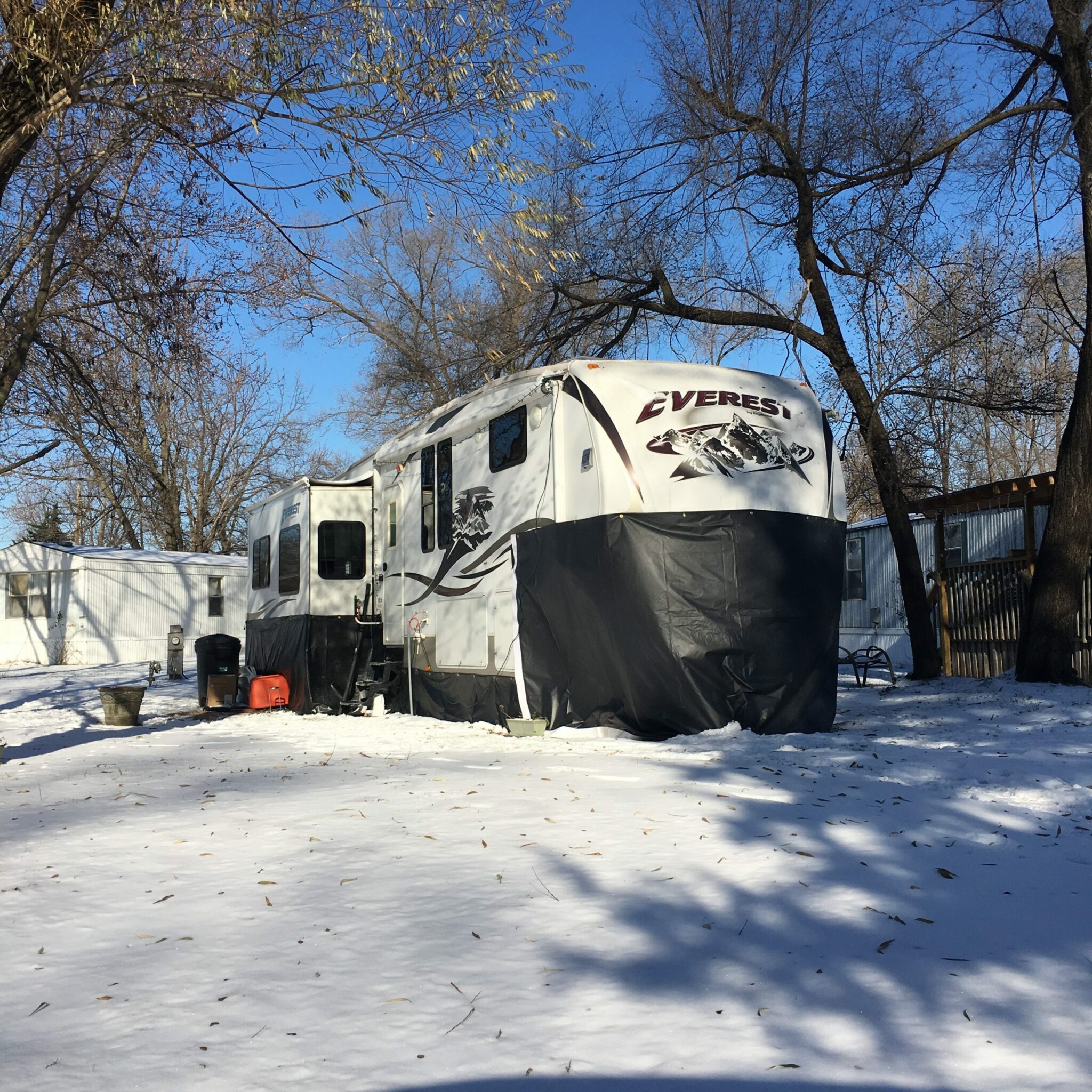














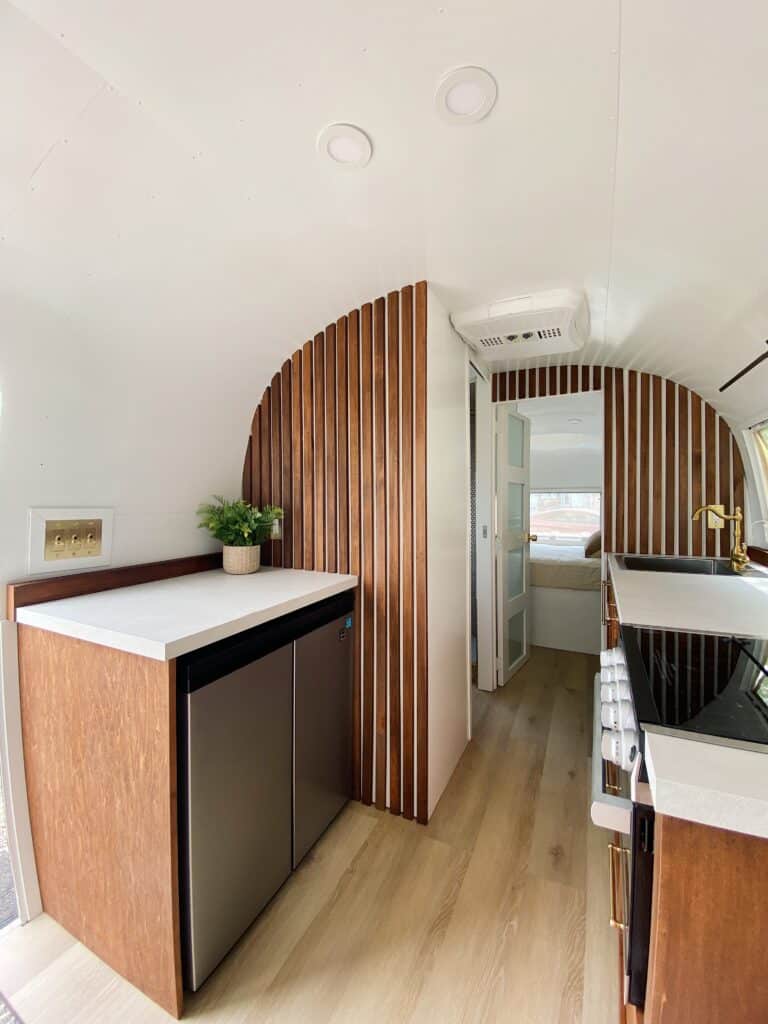

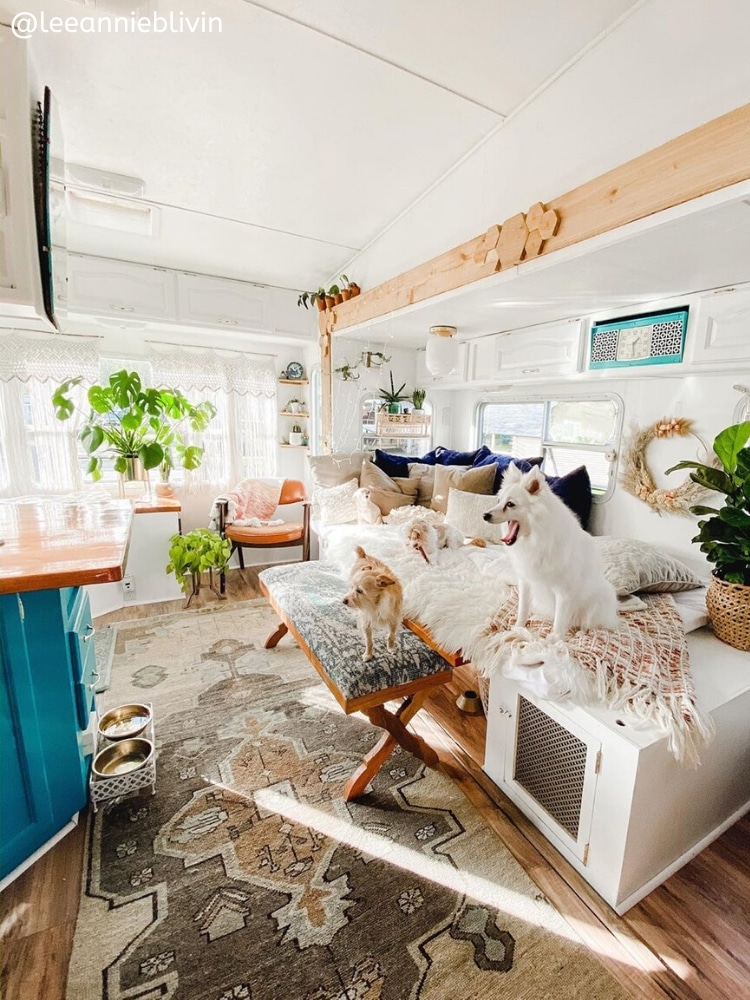

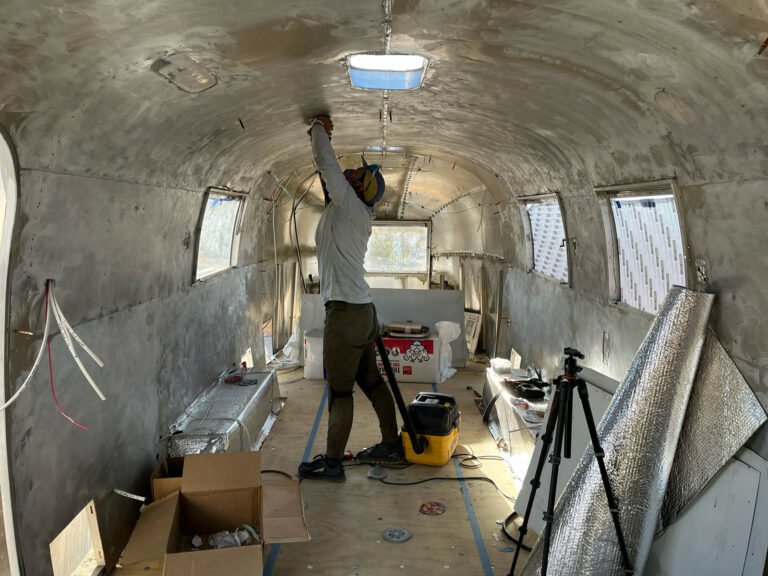
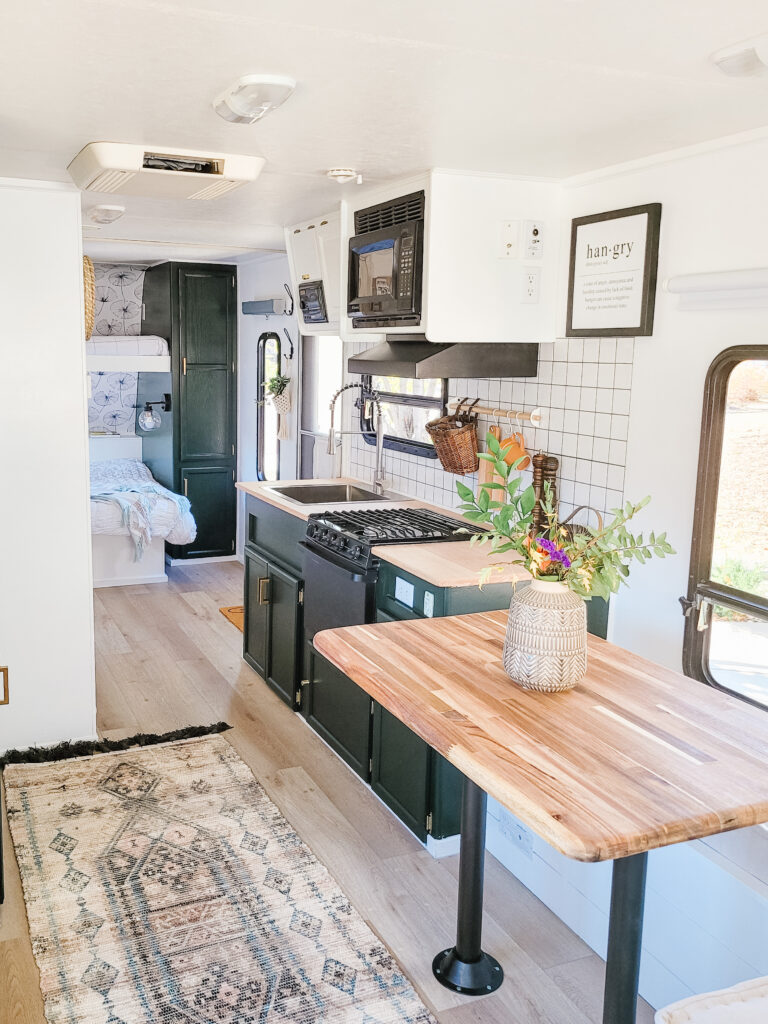
Wow great suggestions. I see so many people ask on RV forums about how to survive winter. Some ask questions that make me feel like they’ve made a big mistake moving into an RV but if they’re armed with your suggestions I think they’ll be much better off. Thanks for the great tips
You’re welcome! And I know what you mean – a few of my family members have asked me for advice about the idea of living stationary in an RV in 4 season climates, and I always try to give them an accurate picture of what winter RV living actually requires. It is possible, but definitely requires forethought and preparation.
We had our black tank freeze one year. Thankfully it warmed up and we were able to drain it. Since then, I solved the problem by adding rv antifreeze to the black tank. Hasn’t frozen since!
Next time your tank valves stick shut, you can use a blow dryer (hair type) to thaw them out quickly! They work great.
Thanks for the tip! I will try that if we have it happen again!
We recently purchased a 41′ fifth wheel and plan to retire next December. I was shocked at how quickly we went through our propane in our 32′ trailer last March in D.C. during an unusual “spring” snowfall of 6″ that occurred. I was googling window shrink film tonight and my wife mentioned having read your blog. Specifically the Styrofoam under the slideouts. We have 4 slideouts. I’m curious, have you ever considered a reflective surface for the slideout roofs in the summer or foam on them during summer? Thanks, Don
Hi Don, we actually have awnings on top of our slides, but if we didn’t have those, adding something reflective on top of them might be worth a try if you’re having trouble keeping RV cool inside (especially if your RV isn’t white). If the foam or Reflectix was too expensive or too bulky to store, perhaps you could even try using HVAC tape to attach mylar “emergency blankets”.
Thank you so much for sharing a great article.
Hi there, great post, learned lots! I’m looking for some feedback on my potential winter setup….I’m gonna make the billboard skirt then place a 100′ 500w electric de-icing cable under the trailer and in the wet bay. My interior will be heated with a total of 2250w between two electric fan heaters. The entire length of my heated fresh water hose will be and insulated and will enter through the bottom of the trailer. I don’t plan on using my furnace at all as I have very limited access to propane. I live in near Vancouver, BC and at the worst we probably have a few weeks of freezing temperatures in the winter.
Do you think this set up will save me from frozen pipes?
Hi Jesse, it sounds like you’ve put a lot of thought into your setup, however I would be hesitant to say for sure whether or not you’ve got everything covered since I’ve never lived anywhere as far north as you, and since we did use propane for heat. Listening to your description the main thing that comes to mind is making sure all your electric heating is wired using a thick enough gauge of wire or extension cords for safety (but you might already be on top of this), and also making sure you have some sort of backup in case your electricity goes out. Have you joined the Facebook group Winter RVing – Let’s Stay Warm Together? I would post your comment there as well and see if any RVers who have experienced conditions like yours can offer any input! Best wishes, -Ashley